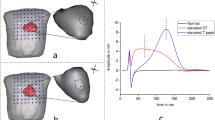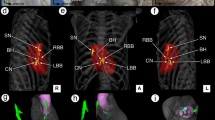Abstract
Our aim in this study is to obtain novel three-dimensional (3-D) images of cardiac electrical excitation that include morphological information on the whole heart. We obtain these 3-D images by projecting anterior and posterior two-dimensional (2-D) current-arrow maps (CAMs) onto a 3-D standard heart model. This standard heart model is adjusted to the individual subject’s heart position by using the coordinates of the sinus node, which are obtained from magnetocardiogram (MCG) signals. The anterior and posterior CAMs are calculated by taking the orthogonal partial derivatives of the normal component of the anterior and posterior MCGs. After adjusting the base current values of the anterior and posterior CAMs, the adjusted CAMs are projected onto the standard heart model. We generated the projected CAMs (PCAMs) of the six phases (atrial, and ventricular, excitation) for seven healthy subjects. The validity of PCAM was evaluated by extracting the maximal current directions and positions from the PCAMs. The maximal current directions and positions during each excitation phase were almost in the same in the seven healthy subjects. Therefore, the PCAMs give us a clear view of the anterior and posterior myocardial excitation for the respective electrophysiological phases.
Similar content being viewed by others
References
Gepstein L, Hayam G, Ben-Haim SA. A novel method for nonfluoroscopic catheter-based Electroanatomical mapping of the heart. Circulation 1997; 95(6): 1611–1622.
Lessick J, Hayam G, Zaretsky A, Reisner SA, Schwartz Y, Ben-Haim SA. Evaluation of inotropic changes in ventricular function by NOGA mapping: comparison with echocardiography. J Appl Physiol 2002; 93: 418–426.
Kobayashi Y, Shimada K, Yamagishi H, et al. Left ventricular electromechanical mapping in stunned myocardium. Circulation 2000; 102: e25–e26.
Bøtker HE, Lassen JF, Hermansen F, et al. Electromechanical mapping for detection of myocardial viability in patients with ischemic cardiomyopathy. Circulation 2001; 103: 1631–1637
Greensite F, Huiskamp G. An improved method for estimating epicardial potentials from the body surface. IEEE Trans Biomed Eng 1998; 45(1): 98–104.
van Oosterom A. The use of the spatial covariance in computing pericardial potentials. IEEE Trans Biomed Eng 1999; 46(7): 778–787.
Modre R, Tilg B, Fischer G, Wach P. Noninvasive myocardial activation time imaging: a novel inverse algorithm applied to clinical ECG mapping data. IEEE Trans Biomed Eng 2002; 49(10): 1153–1161.
Burnes JE, Taccardi B, Rudy Y. A noninvasive imaging modality for cardiac arrhythmias. Circulation 2000; 102: 2152–2158.
Hosaka H, Cohen D. Visual determination of generators of the magnetocardiogram. J Electrocardiol 1976; 9(4): 426–432.
Nakaya Y, Sumi M, Saito K, Fujino K, Murakami M, Mori H. Analysis of current source of the heart using isomagnetic and vector arrow maps. Jpn Heart J 1984; 25(5): 701–711.
Tsukada K, Haruta Y, Adachi A, et al. Multichannel SQUID system detecting tangential components of the cardiac magnetic field. Rev Sci Instrum 1995; 66(10): 5085–5091.
Horigome H, Siono J, Shigemitsu S, et al. Detection of cardiac hypertrophy in the fetus by approximation of the current dipole using magnetocardiography. Pediatr Res 2001; 50(2): 242–245.
Miyashita T, Kandori A, Tsukada K, et al. Construction of tangential vectors from normal cardiac magnetic field components. Proceedings of the 20th annual international conference of the IEEE engineering in medicine and biology society. 1998 October 29–November 1: 520–523.
Kuusisto J, Koskinen R, Mäntynen V, et al. Diversity in activation of healthy atria by magnetocardiographic gradient analysis. In: Proceedings of the 14th International Conference on Biomagnetism. 2004 August 8–12, 407–408.
Yamada S, Tsukada K, Miyashita T, Kuga K, Yamaguchi I. Noninvasive, direct visualization of macro-reentrant circuits by using magnetocardiograms: initiation and persistence of atrial flutter. Europace 2003; 5: 343–350.
Kandori A, Shimizu W, Yokokawa M, et al. Detection of spatial repolarization abnormalities is patients with LQT1 and LQT2 forms of congenital long-QT syndrome. Physiol Meas 2002; 23: 603–614.
Kanzaki H, Nakatani S, Kandori A, Tsukada K, Miyatake K. A new screening method to diagnose coronary artery disease using multichannel magnetocardiogram and simple exercise. Basic Res Cardiol 2003; 98: 124–132.
Tsukada K, Mitsui T, Terada Y, Horigome H, Yamaguchi I. Noninvasive visualization of multiple simultaneously activated regions on torso magnetocardiographic maps during ventricular depolarization. J Electrocardiol 1999; 32(4): 305–313.
Ogata K, Kandori A, Miyashita T, Tsukada K. Visualization method of current distribution in cardiac muscle using a heart model. Trans Jpn Soc Med Biol Eng 2003; 41(1): 25–33.
Nomura M, Nakaya Y, Saito K, et al. Noninvasive localization of accessory pathways by magnetocardiographic imaging. Clin Cardiol 1994; 17: 239–244.
Hren R, Stroink G, Horáček BM. Accuracy of single-dipole inverse solution when localizing ventricular pre-excitation sites: simulation study. Med Biol Eng Comput 1998; 36: 323–329.
Sarvas J. Basic mathematical and electromagnetic concepts of the biomagnetic inverse problem. Phys Med Biol 1987; 32(1): 11–22.
Durrer D, van Dam RTh, Freud GE, Janse MJ, Meijler FL, Arzbaecher RC. Total excitation of the isolated human heart. Circulation 1970; 41: 899–912.
Sato M, Terada Y, Mitsui T, Miyashita T, Kandori A, Tsukada K. Visualization of atrial excitation by magnetocardiogram. Int J Cardiac Imaging 2002; 18: 305–312.
Goldman MJ. Principles of Clinical Electrocardiography. California: Lange Medical Publications, 1986.
Smith WE. Estimation of the spatio-temporal correlations of biological electrical sources from their magnetic field. IEEE Trans Biomed Eng 1992; 39: 997–1004.
Killmann R, Jaros GG, Wach P, et al. Localisation of myocardial ischemia from the magnetocardiogram using current density reconstruction method: computer simulation study. Med Biol Eng Comput 1995; 33: 643–651.
Kandori A, Hosono T, Chiba Y, et al. Classifying cases of fetal Wolff-Parkinson-White syndrome by estimating the accessory pathway from fetal magnetocardiograms. Med Biol Eng Comput 2003; 41: 33–39.
Ogata K, Kandori A, Miyashita T, et al. Projecting cardiac-current images onto a 3-D standard heart model. In: Proceedings of the 25th Annual International Conference of the IEEE Engineering in Medicine and Biology Society. 2003 17–21 September, pp. 517–520.
Author information
Authors and Affiliations
Rights and permissions
About this article
Cite this article
Ogata, K., Kandori, A., Miyashita, T. et al. Visualization of three-dimensional cardiac electrical excitation using standard heart model and anterior and posterior magnetocardiogram. Int J Cardiovasc Imaging 22, 581–593 (2006). https://doi.org/10.1007/s10554-005-9048-5
Received:
Accepted:
Published:
Issue Date:
DOI: https://doi.org/10.1007/s10554-005-9048-5




